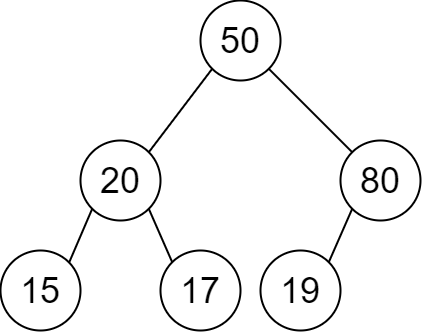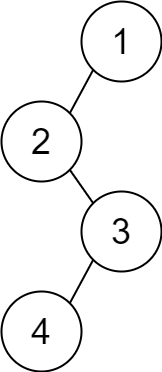- {x}
- Minimum Time to Finish the Race
- Number of Ways to Build House of Cards
- Most Frequent Number Following Key In an Array
- Sort the Jumbled Numbers
- All Ancestors of a Node in a Directed Acyclic Graph
- Minimum Number of Moves to Make Palindrome
- Cells in a Range on an Excel Sheet
- Append K Integers With Minimal Sum
- Create Binary Tree From Descriptions
- Replace Non-Coprime Numbers in Array
- Number of Single Divisor Triplets
- Finding the Topic of Each Post
- Find All K-Distant Indices in an Array
- Count Artifacts That Can Be Extracted
- Maximize the Topmost Element After K Moves
- Minimum Weighted Subgraph With the Required Paths
- Distance to a Cycle in Undirected Graph
- Read More...

Create Binary Tree From Descriptions
You are given a 2D integer array descriptions where descriptions[i] = [parenti, childi, isLefti] indicates that parenti is the parent of childi in a binary tree of unique values. Furthermore,
- If
isLefti == 1, thenchildiis the left child ofparenti. - If
isLefti == 0, thenchildiis the right child ofparenti.
Construct the binary tree described by descriptions and return its root.
The test cases will be generated such that the binary tree is valid.
Example 1:

Input: descriptions = [[20,15,1],[20,17,0],[50,20,1],[50,80,0],[80,19,1]] Output: [50,20,80,15,17,19] Explanation: The root node is the node with value 50 since it has no parent. The resulting binary tree is shown in the diagram.
Example 2:

Input: descriptions = [[1,2,1],[2,3,0],[3,4,1]] Output: [1,2,null,null,3,4] Explanation: The root node is the node with value 1 since it has no parent. The resulting binary tree is shown in the diagram.
Constraints:
1 <= descriptions.length <= 104descriptions[i].length == 31 <= parenti, childi <= 1050 <= isLefti <= 1- The binary tree described by
descriptionsis valid.
2196. Create Binary Tree From Descriptions
Problem Description
Given a 2D integer array descriptions where descriptions[i] = [parent<sub>i</sub>, child<sub>i</sub>, isLeft<sub>i</sub>], construct the binary tree described and return its root. isLeft<sub>i</sub> == 1 indicates child<sub>i</sub> is the left child of parent<sub>i</sub>, otherwise it's the right child.
Solution: Hash Table Approach
This problem can be efficiently solved using a hash table (or dictionary in Python) to track nodes and their relationships. The algorithm proceeds as follows:
-
Initialization: Create a hash table (
nodes) to store nodes where keys are node values and values areTreeNodeobjects. Also, create a set (children) to keep track of all child nodes. -
Iterate through Descriptions: For each description
[parent, child, isLeft]indescriptions:- If
parentisn't innodes, create a newTreeNodefor it. - Do the same for
child. - Add
childto thechildrenset. - Connect
childtoparentas either the left or right child based onisLeft.
- If
-
Find the Root: Iterate through the
nodeshash table. The node whose value is not present in thechildrenset is the root node (since it has no parent). Return this root node.
Time and Space Complexity
-
Time Complexity: O(n), where n is the length of
descriptions. We iterate through the descriptions once to build the tree and once to find the root. All hash table operations (insertion, lookup) take roughly constant time on average. -
Space Complexity: O(n). The hash table
nodesand the setchildrenwill store at most n nodes.
Code Implementation (Python)
# Definition for a binary tree node.
class TreeNode:
def __init__(self, val=0, left=None, right=None):
self.val = val
self.left = left
self.right = right
class Solution:
def createBinaryTree(self, descriptions: List[List[int]]) -> Optional[TreeNode]:
nodes = {} # Hash table to store nodes
children = set() # Set to track children nodes
for parent, child, isLeft in descriptions:
if parent not in nodes:
nodes[parent] = TreeNode(parent)
if child not in nodes:
nodes[child] = TreeNode(child)
children.add(child)
if isLeft:
nodes[parent].left = nodes[child]
else:
nodes[parent].right = nodes[child]
# Find the root: the node not in children
for node_val, node in nodes.items():
if node_val not in children:
return node
return None #Should not happen given problem constraintsCode Implementation (Java)
/**
* Definition for a binary tree node.
* public class TreeNode {
* int val;
* TreeNode left;
* TreeNode right;
* TreeNode() {}
* TreeNode(int val) { this.val = val; }
* TreeNode(int val, TreeNode left, TreeNode right) {
* this.val = val;
* this.left = left;
* this.right = right;
* }
* }
*/
import java.util.*;
class Solution {
public TreeNode createBinaryTree(int[][] descriptions) {
Map<Integer, TreeNode> nodes = new HashMap<>();
Set<Integer> children = new HashSet<>();
for (int[] desc : descriptions) {
int parent = desc[0], child = desc[1], isLeft = desc[2];
nodes.putIfAbsent(parent, new TreeNode(parent));
nodes.putIfAbsent(child, new TreeNode(child));
children.add(child);
if (isLeft == 1) {
nodes.get(parent).left = nodes.get(child);
} else {
nodes.get(parent).right = nodes.get(child);
}
}
for (Map.Entry<Integer, TreeNode> entry : nodes.entrySet()) {
if (!children.contains(entry.getKey())) {
return entry.getValue();
}
}
return null; //Should not happen given problem constraints.
}
}(Other language implementations would follow a similar structure, using the appropriate data structures for hash tables and sets in each language.)